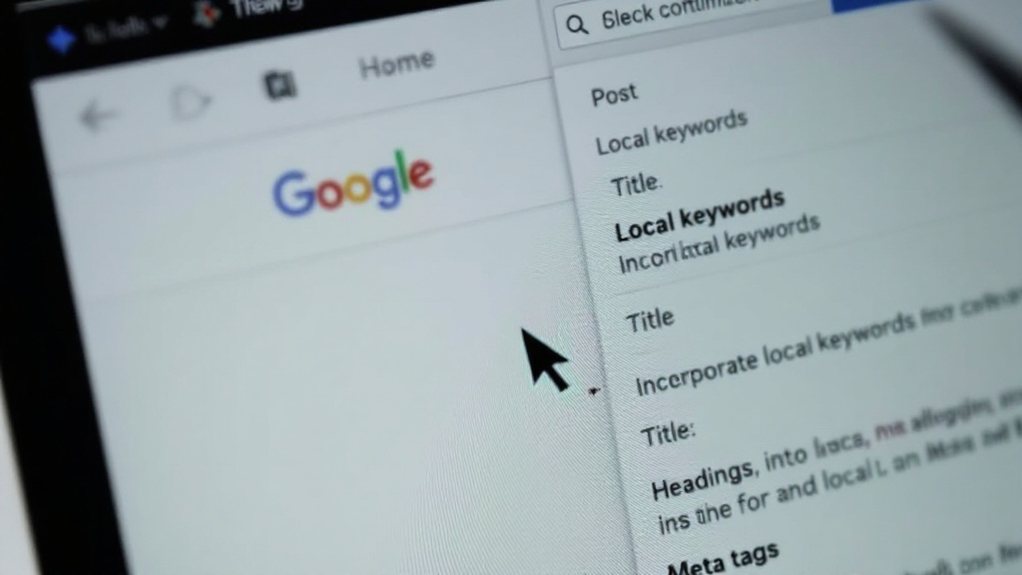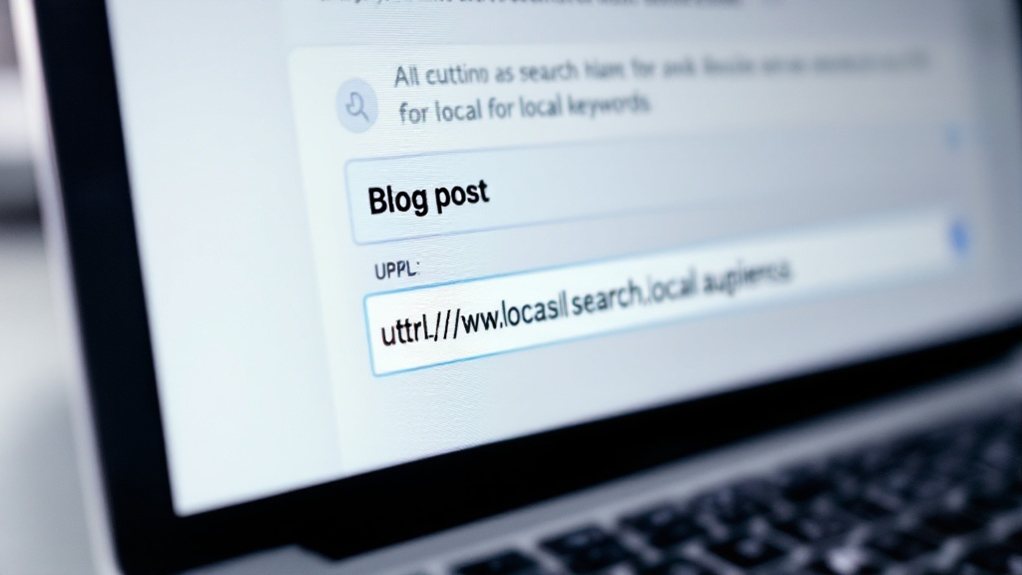To optimize your blog posts for local keywords, start by identifying relevant terms including your business offerings, location modifiers, and long-tail variations. Incorporate primary local keywords in your H1 tags and sprinkle secondary ones throughout the content. Craft compelling, concise titles and meta descriptions that showcase your geographic relevance. Leverage schema markup and optimize visual elements like images and videos. By implementing these strategies, you'll connect with your local audience and improve your visibility in search engines. Continue reading to dive deeper into local SEO best practices.
Identifying Relevant Local Keywords

Identifying the right local keywords is crucial for boosting your blog's visibility in local search results. Start by brainstorming seed keywords, including generic business terms, location modifiers, product/service offerings, and long-tail variations. Utilize keyword research tools like Google Keyword Planner and Semrush to explore data on search volume, competition, and difficulty. Analyzing keyword data, such as monthly searches, CPC, and keyword difficulty, can help prioritize the most impactful keywords. Structure your local keywords by combining main services with locations, adding specifics, and incorporating local landmarks or ZIP codes. Prioritize keywords based on relevance, search volume, cost per click, and competitor analysis. Continuously refine and monitor your keyword performance, adjusting your SEO strategy as needed to maintain search relevance.
Incorporating Local Keywords Into Page Structure

Once you've identified the relevant local keywords, it's time to incorporate them strategically throughout your blog's structure. Start by including your primary local keywords in the H1 tags to maximize their impact. Secondaries can be placed in H2 and H3 tags to support the main theme.
- Ensure your paragraphs are concise and your sentences clear to improve readability and SEO.
- Break up dense text with bullet points and numbered lists for a better user experience.
- Optimize visual elements like images and videos by tagging them with local keywords.
- Prioritize high-quality content that meets user intent to attract the right local audience.
- Target specific local queries using long-tail keywords for higher intent.
- Internal linking with location-based anchor text can reinforce your site's authority on local topics.
Optimizing Titles and URLs for Local Search

Optimizing the titles and URLs of your blog posts is crucial for enhancing their visibility in local search results. Include your business services and cover specific localities in your titles to improve relevance. Use keyword research tools to identify high-value local keywords. Craft attention-grabbing, concise titles that emphasize important keywords. Title tags are an HTML element that designates the title of a web page. Incorporate local keywords in your URLs and use city or state names to target geographic areas. Keep URLs simple, clear, and hierarchical. Position main keywords at the beginning of title tags, and avoid duplication. Stay updated on Google's algorithm changes and analyze competitors to identify local SEO opportunities. Continuously test and iterate your strategies to drive better performance.
Crafting Compelling Meta Descriptions
Crafting compelling meta descriptions is crucial for grabbing attention and driving clicks. Aim for 155 characters or shorter to summarize your blog post's key value proposition concisely, weaving in your targeted local keywords. This strategic approach can significantly boost your click-through rates and attract the right audience. Craft an inviting 155-character text that sounds like a friendly human and demonstrates relevance to the user.
Entice With Concise Summaries
As a savvy content creator, you understand that crafting compelling meta descriptions is crucial for driving targeted traffic to your local business blog. Entice readers with concise summaries that pack a punch:
- Limit descriptions to 155 characters for optimal visibility.
- Align meta text with search intent to captivate your audience.
- Use active, engaging language and include a clear call-to-action.
- Ensure each page has a unique meta description for maximum impact.
- A/B test different variations to determine the highest-performing option.
- Incorporate relevant, local keywords to appeal to your target audience.
Incorporate Targeted Keywords
When crafting your meta descriptions, it's crucial to incorporate targeted local keywords. Conduct thorough local keyword research to identify terms related to your audience's search queries. Utilize geographic keywords like city or state names to match local intent. Tailor these keywords to common search patterns, but avoid overuse to maintain natural writing. Focus on longer, more specific local phrases to reach niche audiences. Highlight key local features or services, and use action-oriented calls-to-action to prompt engagement. Ensure the description accurately reflects the page content and emphasizes user benefits. Test and refine your meta descriptions using SERP analysis tools and A/B testing to optimize for readability and performance. Monitoring keyword performance over time is also important to adjust your strategy as needed.
Enhance Click-Through Rates
With your meta descriptions now optimized for local keywords, the next step is to enhance their click-through rates. Craft compelling copy that captures user attention and highlights the unique value of your content. Use:
- Persuasive language to entice readers
- Relevant calls-to-action like "Learn More" or "Shop Now"
- Visual hierarchy to ensure clear presentation in SERPs
- A/B testing to refine performance
- Automated tools to streamline the optimization process
Incorporate visually appealing imagery to further improve click-through rates from search results.
Integrating Local Keywords Into Content
Weave local keywords strategically into your content to boost relevance. Incorporate geo-targeted terms to connect with your local audience. Craft content that resonates with user search intent for enhanced engagement. [Local keywords create a clear link between content and a business's geographical location, affecting how search engines perceive the relevance of content to specific locations and influencing ranking in local search results.
Placing Keywords Strategically
Effectively integrating local keywords into your content is a crucial aspect of blog post optimization. When placing keywords strategically, focus on primary keyword positioning by including them in your title, meta description, and first paragraph. Supplement these with secondary keywords at a 1-2% density throughout your text to enrich the content without overloading it.
- Craft attention-grabbing titles that incorporate relevant local keywords to capture targeted traffic and improve search rankings.
- Use semantic keyword variations to target a broader audience and ensure comprehensive content coverage.
- Maintain a balanced keyword density to avoid keyword stuffing while optimizing for search engines.
- Break up content with keyword-rich subheadings to enhance readability and search performance.
- Leverage bulleted lists to emphasize key points and incorporate targeted keywords.
Reviewing keyword performance regularly helps adapt to changing audience behaviors and search trends.
Incorporating Geo-Targeted Terms
Placing local keywords strategically within your content is the next step in optimizing your blog posts for targeted traffic. Integrate them naturally into your meta tags, headers, and body copy without over-optimizing. Use location-specific terms in internal links to improve site navigation. Diversify your content types, like blogs and landing pages, to showcase your local expertise. Local keywords help businesses improve online visibility in specific geographic areas. Hone in on hyperlocal themes relevant to your neighborhood or community events. Regular performance monitoring and keyword refinement will ensure your content stays aligned with customer needs and search trends. Combining local SEO best practices, like structured data and directory listings, will further boost your online visibility within your target market.
Enhancing User Relevance
Tailoring your blog content to resonate with local interests is a surefire way to enhance user relevance. Focus on hyper-local topics like community events, neighborhood news, and hidden gems that your audience cares about. Provide insider insights to build trust and authority.
- Feature user-generated content like customer testimonials or local business success stories.
- Incorporate timely updates on recent local trends and news to keep your content fresh.
- Answer common local questions or solve problems through informative blog posts.
- Utilize long-tail keywords that include location details for improved local rankings.
- Structure your content with engaging headlines, clear subheadings, and visuals to drive user engagement.
Leveraging Internal Linking for Local Authority
As you seek to establish local authority through your blog content, leveraging internal linking should be a key component of your strategy. Thoughtfully placed internal links can enhance user experience, improve content organization, and signal relevance to search engines. Focus on keyword mapping to pair pages with optimal keywords, and organize your content into topic clusters that interlink local themes. Use descriptive anchor text and include geolocation signals where appropriate. Regularly review and update your internal links to maintain site relevance and SEO performance. By optimizing your internal linking, you can boost your local authority and drive more qualified traffic to your blog.
Utilizing Location-Based Schema Markup
You know that location-based schema markup is a must for improving local search visibility. It helps you showcase key business details, from operating hours to customer reviews, in search results. Maximizing this structured data can give your local SEO a real boost, so let's dive into how to make the most of it.
Implementing Schema Markup
Implementing location-based schema markup can significantly boost your local SEO efforts. Utilize specific schema types like "Local Business," "Location Page," and "Location-Based Events" to enhance search engine visibility. This improves how search engines interpret and display your content in local search results. Take advantage of tools like Google's Structured Data Markup Helper and schema.org generators to simplify the implementation process.
- Embed schema markup directly into your HTML code for optimal indexing.
- Leverage JSON-LD format to structure your schema data.
- Validate your schema markup using Google's Structured Data Testing Tool.
- Maintain consistent business details in schema and visible content.
- Regularly update your schema to reflect changes in your business information.
Optimizing Local Business Data
Optimizing your local business data by leveraging location-based schema markup is a powerful strategy to elevate your online presence. Incorporate location-specific keywords, document your full address, and highlight unique location features. Encourage local customers to leave reviews, and customize content to reflect their preferences. Combine this with techniques like data deduplication and real-time processing to enhance your local SEO. Optimize for voice search and mobile-friendly content, and use the geographic data in your schema markup. Continuously monitor performance and prioritize location-specific content creation. Regularly update your data, set up quality checks, and use automation tools to maintain accuracy and consistency across platforms.
Enhancing Search Visibility
Enhancing your search visibility is paramount for any local business. Schema markup is essential for providing structured data that helps search engines understand and display your business information. Implementing schema markup can improve click-through rates, generate rich snippets, and boost local search visibility. To optimize your schema markup:
- Utilize tools like Google's Structured Data Markup Helper and Schema Markup Validator to ensure accurate implementation.
- Provide detailed location-based information, such as business hours and services.
- Maintain consistency in your NAP (Name, Address, Phone Number) across all schema markups.
- Leverage JSON-LD for its structured data benefits.
- Regularly monitor and adjust your schema markup based on user feedback and performance.
Optimizing Images and Videos for Local SEO
When optimizing images and videos for local SEO, the quality and presentation of your visual content can significantly impact your business's online visibility and credibility. Use authentic, high-quality photos to build trust and improve local SEO, capturing your business from various angles. Properly size and format your images for web use, and leverage compression tools to enhance page performance. Geotag your visual content to associate your business with specific locations, and incorporate relevant keywords in image filenames, descriptions, and alt text. Include location references and captions in your videos to strengthen local connections. By optimizing your visual media, you can effectively reach and engage your target local audience.
Monitoring Local Keyword Performance
Efficient monitoring of local keyword performance is crucial for businesses seeking to enhance their online visibility and reach within specific geographic areas. Tools like Keyword.com, Wincher, and BrightLocal offer valuable insights, including real-time updates, ranking histories, and customizable reports. By leveraging these solutions, you can:
- Track ranking fluctuations and monitor your competitors' local SEO strategies.
- Segment data by location to optimize content and target specific audiences.
- Integrate with Google Search Console for a comprehensive view of your performance.
- Measure the ROI of your local SEO efforts and make data-driven decisions.
- Enhance the customer experience by delivering personalized, location-specific content.
Iterating and Refining Local SEO Strategies
Refining your local SEO strategies is an ongoing process, one that requires a keen eye for detail and a willingness to experiment. A/B testing is a powerful tool, allowing you to compare variations of your web pages and listings to identify what resonates best with your audience. Content optimization, including the use of long-tail keywords and internal linking, can further enhance your local visibility. Carefully managing your Google Business Profile, from utilizing attributes to regularly updating content, is essential for maintaining relevance and engagement.
| Technique | Description |
|---|---|
| Personalization-Based Testing | Tailor content to user intent and geography |
| Voice Search Optimization | Incorporate natural language queries |
| Multivariate Testing | Evaluate multiple page elements simultaneously |
| Structured Data Testing | Improve click-through rates with enhanced search results |
